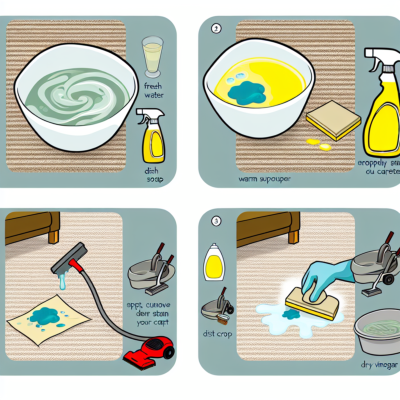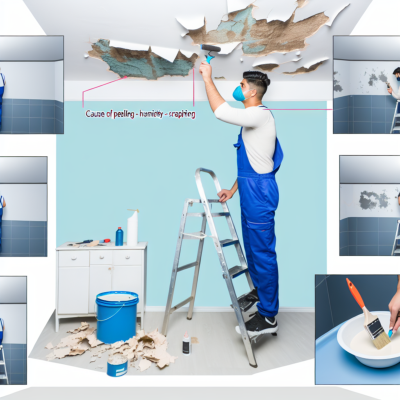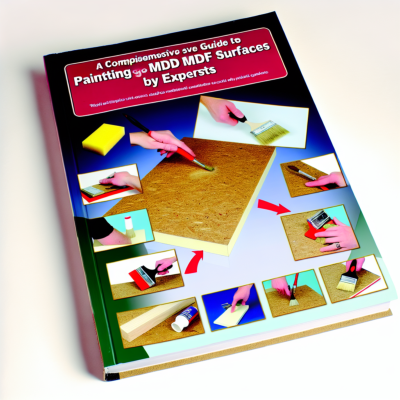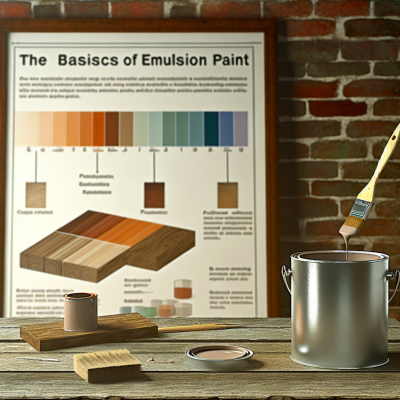Lead paint is a common hazard that can be found in many older homes and buildings. It was commonly used in the past due to its durability and ability to resist moisture. However, it is now known to be highly toxic and can pose serious health risks, especially to young children and pregnant women.
In this comprehensive guide, we will explore the importance of detecting lead paint in your home and provide you with the necessary information to deal with it safely and effectively. We will discuss the health risks associated with lead exposure, the signs and symptoms of lead poisoning, and the various testing methods available.
Lead poisoning can have serious consequences on a person's health, especially for children. It can lead to developmental delays, learning disabilities, and behavior problems. Pregnant women who are exposed to lead can also pass it on to their unborn child, which can result in premature birth, low birth weight, and developmental issues.
It is crucial to be aware of the signs and symptoms of lead poisoning, as early detection and intervention can help prevent further harm. Common symptoms include abdominal pain, vomiting, constipation, fatigue, and irritability. If you or your child experience any of these symptoms, it is important to seek medical attention and get tested for lead exposure.
There are various testing methods available to detect lead paint in your home, including DIY test kits and professional inspections. We will discuss the pros and cons of each method and provide you with guidance on how to choose the best option for your situation. Additionally, we will provide step-by-step instructions on how to safely remove lead paint and minimize the risk of exposure.
By following the advice and recommendations in this comprehensive guide, you can ensure the safety and well-being of your family and minimize the risks associated with lead paint. Remember, early detection and proper handling are key to protecting yourself and your loved ones from the dangers of lead poisoning.
Identifying Lead Paint: Signs and Symptoms
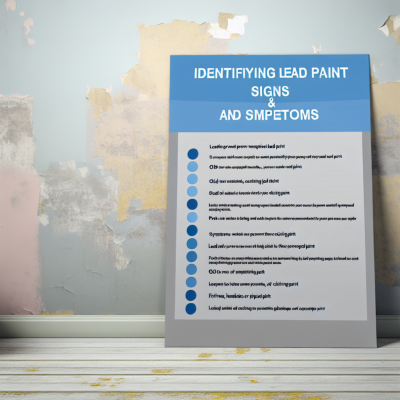
Lead paint can be found in many homes, particularly those built before 1978. It is important to be able to identify lead paint in order to take the necessary precautions and ensure the safety of yourself and your family. Here are some signs and symptoms that can help you identify lead paint:
- Visual inspection: One of the easiest ways to identify lead paint is through a visual inspection. Lead paint often has a distinct look and may appear cracked, chipped, or peeling. It can also have a chalky or dusty appearance.
- Testing: If you are unsure whether a surface has lead paint, you can perform a lead paint test. There are DIY test kits available that can help you determine if lead is present.
- Age of the building: As mentioned earlier, lead paint was commonly used in homes built before 1978. If you live in an older home, there is a higher likelihood of lead paint being present.
- Location: Lead paint is often found on windows, doors, and trim. These areas are more prone to wear and tear, which can result in lead paint being exposed.
- Health symptoms: Exposure to lead paint can cause various health symptoms. These can include abdominal pain, headaches, fatigue, irritability, and difficulty concentrating. If you or your family members are experiencing these symptoms, it may be an indication of lead exposure.
If you suspect that you have lead paint in your home, it is important to take appropriate action. This may involve consulting with a professional lead inspector or contractor for further testing and removal. Remember, the safety of your family should always be a top priority when dealing with lead paint.
How can you tell if you have lead paint?
If you live in an older home, built before 1978, there is a chance that it may contain lead paint. Lead-based paint was commonly used in homes before its ban due to its durability and ability to resist moisture. However, it was later discovered that lead is a highly toxic substance, especially to children and pregnant women.
There are several ways to determine if your home has lead paint:
| Visual Inspection | One way to identify lead paint is through a visual inspection. Look for paint that is cracking, chipping, or peeling. Lead paint often forms a distinct pattern of 'alligatoring' or 'checking,' which looks like the skin of an alligator or a series of interconnected cracks. It may also have a chalky or powdery appearance. |
| Lead Testing Kits | Lead testing kits are available at hardware stores and can be used to test for the presence of lead in paint. These kits typically include a swab that changes color in the presence of lead. Follow the instructions carefully to get accurate results. |
| Professional Inspection | If you are unsure or want a more accurate assessment, you can hire a professional inspector who is trained in lead paint detection. They will use specialized equipment, such as an X-ray fluorescence (XRF) analyzer or a portable X-ray machine, to test the paint and determine if it contains lead. |
It is important to note that lead paint is not a danger unless it is deteriorating or disturbed. If the paint is in good condition and not being disturbed, it is generally safe. However, if you plan to renovate or disturb the paint in any way, it is crucial to take necessary precautions to prevent lead exposure.
If you suspect that your home has lead paint, it is recommended to consult with a professional to assess the situation and develop a plan for lead paint removal or containment to ensure the safety of you and your family.
What are symptoms of being around lead paint?
Exposure to lead paint can have serious health effects, particularly for children and pregnant women. Common symptoms of being around lead paint include:
| Age Group | Symptoms |
|---|---|
| Children |
|
| Pregnant Women |
|
If you or your child experience any of these symptoms and suspect exposure to lead paint, it is important to seek medical attention and get your home tested for lead paint. Prompt action can help prevent further health complications.
What are signs of lead poisoning in a child?
Lead poisoning occurs when a child ingests or inhales lead, which can be found in various sources such as lead-based paint, contaminated soil, and water pipes. Lead poisoning can have serious health effects, especially in children, and it is important to be aware of the signs and symptoms.
Here are some common signs of lead poisoning in a child:
- Developmental delays: Lead can affect the development of a child's brain and nervous system, leading to delays in milestones such as talking, walking, and learning.
- Behavioral changes: Children with lead poisoning may exhibit irritability, hyperactivity, and difficulty concentrating.
- Loss of appetite: Lead poisoning can cause a decreased appetite, resulting in weight loss or failure to gain weight.
- Learning difficulties: Lead can interfere with a child's ability to learn, leading to difficulties in school and academic performance.
- Low energy: Children with lead poisoning may appear tired or sluggish.
- Abdominal pain and vomiting: Ingesting lead can cause abdominal pain and vomiting.
- Constipation: Lead poisoning can lead to constipation and stomach discomfort.
- Pale skin: Some children with lead poisoning may have a pale or grayish appearance.
- Seizures: In severe cases, lead poisoning can lead to seizures or convulsions.
If you suspect that your child may have lead poisoning, it is important to seek medical attention as soon as possible. A blood test can determine the level of lead in the child's body. Early detection and intervention can help prevent further complications and promote the child's overall health and development.
Please note: The signs and symptoms mentioned above are not exclusive to lead poisoning and can be caused by other factors as well. Consulting with a healthcare professional is essential for an accurate diagnosis.
laundry detergent substitute
Testing for Lead Paint: Kits and DIY Methods

Testing for lead paint is an essential step in ensuring the safety of your home, especially if it was built before 1978 when lead-based paint was commonly used. There are several options available for testing for lead paint, including kits and DIY methods.
Lead paint test kits are widely available and easy to use. They typically include test swabs or strips that can be rubbed on the painted surface. The swabs will change color if lead is detected, indicating the presence of lead paint. These kits are convenient and provide quick results, making them a popular choice for homeowners.
DIY methods for testing lead paint include using household items and tools. One common method involves using a damp cloth or sponge and rubbing it on the painted surface. If the cloth or sponge turns a pinkish color, it may indicate the presence of lead. However, this method is not as accurate as using test kits and should be followed up with professional testing if lead is suspected.
It is important to note that while test kits and DIY methods can provide an initial indication of the presence of lead paint, they are not always 100% accurate. To get a definitive answer, it is recommended to consult a professional lead inspector or testing laboratory. They have access to specialized equipment and techniques that can provide more accurate results.
| Pros of Lead Paint Test Kits | Cons of Lead Paint Test Kits |
|---|---|
| Easy to use | May not be 100% accurate |
| Provide quick results | Can only detect lead on the surface |
| Convenient for homeowners | Do not provide information on lead levels |
In conclusion, testing for lead paint is an important step in maintaining a safe environment. While lead paint test kits and DIY methods can provide initial indications of lead presence, it is recommended to consult a professional for more accurate results and information on lead levels. Remember, the safety of your home and family should always be a top priority.
What is the easiest way to test for lead?
Testing for lead is an important step in ensuring the safety of your home, especially if it was built before 1978 when lead-based paint was commonly used. There are several methods for testing for lead, but the easiest way is to use a lead test kit.
A lead test kit typically contains swabs or strips that you can use to test various surfaces in your home for the presence of lead. The process is simple and can be done by following these steps:
| Step | Description |
|---|---|
| 1 | Select the area to be tested. It is recommended to test areas with peeling or chipping paint, as well as any areas where children frequently spend time, such as windowsills and door frames. |
| 2 | Open the lead test kit and remove a swab or strip. |
| 3 | Rub the swab or strip on the selected area, making sure to apply enough pressure to transfer any potential lead onto the testing material. |
| 4 | Wait for the specified amount of time as indicated in the instructions of the lead test kit. |
| 5 | Observe the color change on the swab or strip. If it turns pink or red, it indicates the presence of lead. |
| 6 | Dispose of the used swab or strip according to the instructions provided with the lead test kit. |
Using a lead test kit is a quick and reliable way to determine if lead is present in your home. If the test indicates the presence of lead, it is important to take appropriate steps to address the issue and ensure the safety of your family, such as contacting a professional lead abatement contractor.
Remember, testing for lead is an essential part of maintaining a healthy living environment and preventing lead poisoning, especially in homes with young children. Regularly testing for lead and taking necessary actions can help protect your family from the harmful effects of lead exposure.
Can vinegar test for lead paint?
There is a common belief that vinegar can be used as a test for lead paint. However, this method is not reliable and should not be solely relied upon for accurate results.
Vinegar is acidic in nature, and it is believed that if it reacts with the lead in paint, it will cause a color change. The theory is that vinegar will cause the paint to bubble and fizz if it contains lead.
While vinegar may cause a reaction on the surface of the paint, it does not necessarily indicate the presence of lead. Other factors, such as the type of paint or the presence of other substances, can also cause a reaction with vinegar.
To accurately test for lead paint, it is recommended to use a lead paint test kit or consult a professional. These methods are more reliable and will provide accurate results.
It is important to take lead paint testing seriously, as exposure to lead can be harmful, especially for children and pregnant women. Lead poisoning can cause a range of health issues, including developmental delays and cognitive impairment.
If you suspect that your home contains lead paint, it is best to consult a professional for proper testing and removal. They will have the knowledge and equipment to safely handle and remove lead paint, minimizing the risk of exposure.
In summary, while vinegar may cause a reaction with paint, it is not a reliable method for testing for lead paint. It is best to use a lead paint test kit or consult a professional for accurate results.
Lead Paint in Homes and Apartments: Safety Measures
Lead-based paint was commonly used in homes and apartments before its ban in the late 1970s. However, it still poses a significant risk to the health of individuals, especially young children and pregnant women. To ensure the safety of residents, it is crucial to take appropriate safety measures when dealing with lead paint.
1. Inspection: Before purchasing or renting a home or apartment, it is important to have it inspected for the presence of lead paint. Hire a certified professional to conduct a thorough inspection and assess the risk level. This will help you determine the necessary precautions to take.
2. Encapsulation: If the lead paint is found and is in good condition, consider encapsulating it instead of removing it. Encapsulation involves covering the lead paint with a special coating that prevents it from chipping or peeling. This can be a cost-effective and less disruptive solution.
3. Removal: If the lead paint is deteriorating, damaged, or poses a high risk, it may need to be removed. However, lead paint removal should be done by professionals who are trained in lead-safe work practices. They will ensure that the dust and debris are properly contained and disposed of, minimizing the risk of lead exposure.
4. Safe Work Practices: If you decide to conduct minor repairs or renovations in a home or apartment with lead paint, follow safe work practices. This includes using appropriate personal protective equipment, such as gloves and masks, and minimizing the generation of dust and debris. Use wet methods to control dust and clean the area thoroughly afterwards.
5. Regular Cleaning: Regularly clean surfaces that may have lead dust accumulation, such as window sills, floors, and door frames. Use wet cleaning methods and avoid dry sweeping or vacuuming, as these can spread lead dust into the air. Additionally, wash hands and toys frequently, especially for young children who are more prone to hand-to-mouth contact.
6. Regular Testing: Periodically test for lead dust and lead levels in homes and apartments, especially if there are young children or pregnant women residing in the premises. This will help ensure that the safety measures are effective and that any necessary actions can be taken promptly.
By following these safety measures, you can minimize the risk of lead exposure and create a safe living environment for yourself and your family.
Can you safely live in a house with lead paint?
Living in a house with lead paint can pose serious health risks, especially for children and pregnant women. Even small amounts of lead dust or paint chips can be harmful if ingested or inhaled. Lead poisoning can lead to a range of health problems, including developmental delays, learning disabilities, and even organ damage.
However, it is possible to safely live in a house with lead paint by taking appropriate precautions. The first step is to determine the extent of lead paint in your home through a professional inspection or a lead testing kit. If lead paint is present, it is important to minimize the risk of exposure.
how to antique a mirror
Here are some steps you can take to safely live in a house with lead paint:
- Keep the paint in good condition: Regularly inspect the paint for any signs of peeling, chipping, or deteriorating. If you notice any issues, repair and repaint the area using lead-safe practices.
- Keep surfaces clean: Regularly clean floors, windowsills, and other surfaces to remove any lead dust. Use a damp cloth or mop to minimize the spread of dust.
- Practice good hygiene: Wash hands frequently, especially before eating, and encourage children to do the same. This helps prevent the ingestion of any lead dust that may have been picked up on hands or objects.
- Provide a safe play area: Create a designated play area that is free from any lead paint hazards. Use rugs or mats to cover any lead-contaminated floors.
- Take precautions during renovations: If you plan to renovate your home, hire a certified contractor who is trained in lead-safe work practices. They will know how to safely contain and remove lead paint during the renovation process.
While these precautions can help reduce the risk of lead exposure, it is important to remember that the only way to completely eliminate the risk is to remove all lead paint from your home. If you are concerned about the presence of lead paint, it is recommended to consult with a professional to assess and address the issue.
In summary, living in a house with lead paint can be done safely by taking appropriate precautions and following lead-safe practices. However, it is crucial to regularly monitor and maintain the paint, practice good hygiene, and seek professional help when needed to ensure the safety of everyone in the household.
How do you deal with lead-based paint in a house?
Dealing with lead-based paint in a house is a serious matter that requires proper precautions to ensure the safety of those living in the house. Here are some steps to take when dealing with lead-based paint:
| Step | Description |
|---|---|
| 1 | Assess the situation |
| 2 | Test for lead |
| 3 | Contain the area |
| 4 | Use proper protective equipment |
| 5 | Minimize dust and debris |
| 6 | Remove or encapsulate the lead-based paint |
| 7 | Dispose of waste properly |
| 8 | Clean up thoroughly |
| 9 | Monitor the area |
Assessing the situation involves determining the extent of the lead-based paint in the house and identifying any risks or hazards. Testing for lead is crucial to confirm the presence of lead-based paint. Containing the area is important to prevent the spread of dust and debris during the removal process.
Using proper protective equipment, such as gloves, goggles, and a respirator, is vital to protect yourself from exposure to lead particles. Minimizing dust and debris is essential to prevent contamination of other areas in the house.
Removing or encapsulating the lead-based paint can be done depending on the condition of the paint and the level of risk it poses. Properly disposing of the waste is crucial to prevent further exposure to lead.
After the removal process, it is important to clean up thoroughly using wet methods and HEPA vacuums to ensure that all lead particles are removed. Monitoring the area periodically to check for any signs of deterioration or recontamination is also recommended.
Dealing with lead-based paint requires careful planning, proper equipment, and adherence to safety guidelines. It is always recommended to seek professional assistance if you are unsure or uncomfortable with the process.
What are the side effects of living in a house with lead paint?
Living in a house with lead paint can have serious health implications, especially for children and pregnant women. Lead is a toxic metal that can cause a range of health problems when ingested or inhaled.
1. Neurological effects: Lead exposure can affect the development of the brain and nervous system, leading to learning disabilities, decreased IQ, and behavioral problems in children. It can also cause memory loss, difficulty concentrating, and irritability in adults.
2. Physical effects: Lead poisoning can result in various physical symptoms, such as abdominal pain, fatigue, constipation, and headaches. It can also cause muscle weakness, joint pain, and poor appetite.
3. Developmental effects: Children who are exposed to lead paint can experience delays in their physical and mental development. This can manifest as delayed growth, speech and language problems, and difficulties with coordination and motor skills.
4. Reproductive effects: Pregnant women who are exposed to lead paint are at risk of complications, including premature birth, low birth weight, and developmental issues in their babies. Lead can also be passed from the mother to the fetus through the placenta, potentially causing long-term harm.
5. Cardiovascular effects: Prolonged exposure to lead can increase the risk of high blood pressure, heart disease, and stroke in adults. It can also lead to anemia, a condition characterized by a low red blood cell count.
6. Renal effects: Lead can damage the kidneys and impair their function. This can result in kidney disease, kidney failure, and an increased risk of kidney-related health problems.
7. Behavioral effects: Lead exposure has been linked to behavioral issues, including aggression, hyperactivity, and attention deficit hyperactivity disorder (ADHD). Children who are exposed to lead paint may exhibit difficulties in regulating their emotions and behavior.
It is important to note that the severity of the side effects can vary depending on factors such as the level of exposure, duration of exposure, and individual susceptibility. However, even low levels of lead exposure can be harmful, so it is crucial to take precautions and address any potential lead paint hazards in your home.
What to Do If You Find Lead Paint
Finding lead paint in your home can be concerning, but it's important to take action to minimize the risks. Here's what you should do if you discover lead paint:
- Do not disturb the paint: If you find lead paint, it's important not to disturb it. Avoid sanding, scraping, or burning the paint, as this can release harmful lead dust into the air.
- Keep children away: If you have children or pregnant women in the household, it's crucial to keep them away from any areas with lead paint. Be sure to restrict access and prevent them from touching or ingesting any paint chips.
- Consult a professional: It's recommended to hire a professional lead inspector or contractor who is trained in lead-safe practices. They can assess the situation and provide guidance on the best course of action.
- Consider encapsulation or removal: Depending on the condition of the lead paint, you may choose to encapsulate it or remove it completely. Encapsulation involves sealing the paint with a special coating, while removal requires careful stripping or abatement procedures.
- Follow proper safety measures: If you decide to remove the lead paint yourself, it's crucial to follow safety measures to protect yourself and others. This includes using appropriate personal protective equipment (PPE), wetting the area to minimize dust, and properly disposing of any waste.
- Monitor for lead exposure: After addressing the lead paint issue, it's important to periodically monitor for lead exposure. This can be done through blood lead level testing for children or by using lead test kits to check for any remaining lead dust or paint chips.
- Maintain a clean environment: To minimize the risks of lead exposure, it's important to maintain a clean environment. Regularly clean surfaces and floors with wet methods to prevent the accumulation of dust.
- Seek medical advice if necessary: If you or your family members exhibit symptoms of lead poisoning, such as abdominal pain, headaches, or cognitive issues, it's important to seek medical advice immediately. A healthcare professional can provide appropriate testing and treatment if needed.
Remember, the presence of lead paint doesn't need to be a cause for panic, but it does require proactive steps to ensure the safety of your household. By following these guidelines and seeking professional assistance when necessary, you can effectively deal with lead paint and protect yourself and your loved ones.
What do you do if you find lead paint?
If you suspect that your home may contain lead paint, it is important to take immediate action to protect yourself and your family. Here are the steps you should follow:
archangel 12
1. Confirm the presence of lead paint: Contact a certified lead inspector or a professional lead abatement contractor to conduct a thorough inspection of your home. They will use specialized equipment to test for the presence of lead in the paint and provide you with accurate results.
2. Limit access to the affected areas: If lead paint is found, it is crucial to prevent further exposure. Restrict access to the areas where lead paint is present, especially if you have young children or pregnant women in the household. Consider sealing off the affected areas with plastic sheets or tape to minimize dust and prevent the spread of lead particles.
3. Maintain cleanliness: Regularly clean and dust your home to reduce the risk of lead exposure. Use a damp cloth or mop to minimize the spread of lead dust. Avoid using traditional brooms or dry dusting methods, as they can stir up lead particles and make them airborne.
4. Consult with professionals: Seek guidance from lead abatement professionals or local health agencies to determine the appropriate course of action. They can provide you with information on safe removal or encapsulation methods, as well as recommend certified contractors who specialize in lead paint removal.
5. Follow safe removal practices: If you decide to remove lead paint yourself, follow safe practices to minimize exposure. Wet the area before scraping or sanding to reduce dust, and wear protective clothing, gloves, and a mask. Dispose of lead-contaminated materials properly, following local regulations.
6. Consider professional lead abatement: In some cases, it may be best to hire professionals for lead paint removal. They have the expertise and equipment to safely remove lead paint from your home, reducing the risk of exposure and ensuring proper disposal.
7. Test for lead in soil and water: If you suspect that lead paint has contaminated your soil or water, contact your local health department or environmental agency for guidance. They can provide information on how to test and remediate lead-contaminated soil or water sources.
Remember, lead paint poses serious health risks, especially to children and pregnant women. It is crucial to take immediate action if you find lead paint in your home to ensure a safe and healthy living environment for you and your family.
Can you just paint over lead-based paint?
Painting over lead-based paint may seem like a quick and easy solution, but it is not recommended. While it may temporarily cover the lead-based paint, it does not address the underlying issue of lead contamination. Lead-based paint can deteriorate over time, releasing lead dust and particles into the air, which can be harmful if inhaled or ingested.
Lead dust can settle on surfaces such as floors, windowsills, and countertops, posing a risk, especially to children who may come into contact with it. Simply painting over it does not remove or encapsulate the lead-based paint, and it may continue to deteriorate underneath the new paint layer.
To properly deal with lead-based paint, it is important to follow safe removal procedures. This typically involves hiring a certified lead abatement professional who can safely remove the lead-based paint without causing further contamination.
It is crucial to take proper precautions when dealing with lead-based paint to protect yourself, your family, and the environment. Always consult with a professional to assess the situation and determine the best course of action.
Read more:
- How to paint aluminium
- open a can without a can opener
- mdf paint
- how to get slime out of clothes
- how to get rid of paint smell
- how to get water out of iphone
- pinata ideas
- how to get sunscreen out of fabric
- things to do in summer
- washing soda vs baking soda
- paint peeling in bathroom
- paint for upvc doors
- mould resistant paint
- painting after removing wallpaper
- things to do as a couple
- sandpaper grades
- baking soda and vinegar cleaning
- how to hack key fob doors apartment
- how to paint a garage door
- can you paint laminate floors
- oil based paint for walls
- what is emulsion paint
- how to clean gloss paint brushes
- laundry detergent substitute
- how to antique a mirror
- how to get a bird out of your house
- how to remove rust from stainless steel
- how many fixer upper families still live in their homes
- apple tablet with pen
- how to clean white fabric shoe
- painting pine furniture
- top selling vintage items on etsy
- best places to live in texas
- The Magnificent Waco Castle
- how to balance a ceiling fan





